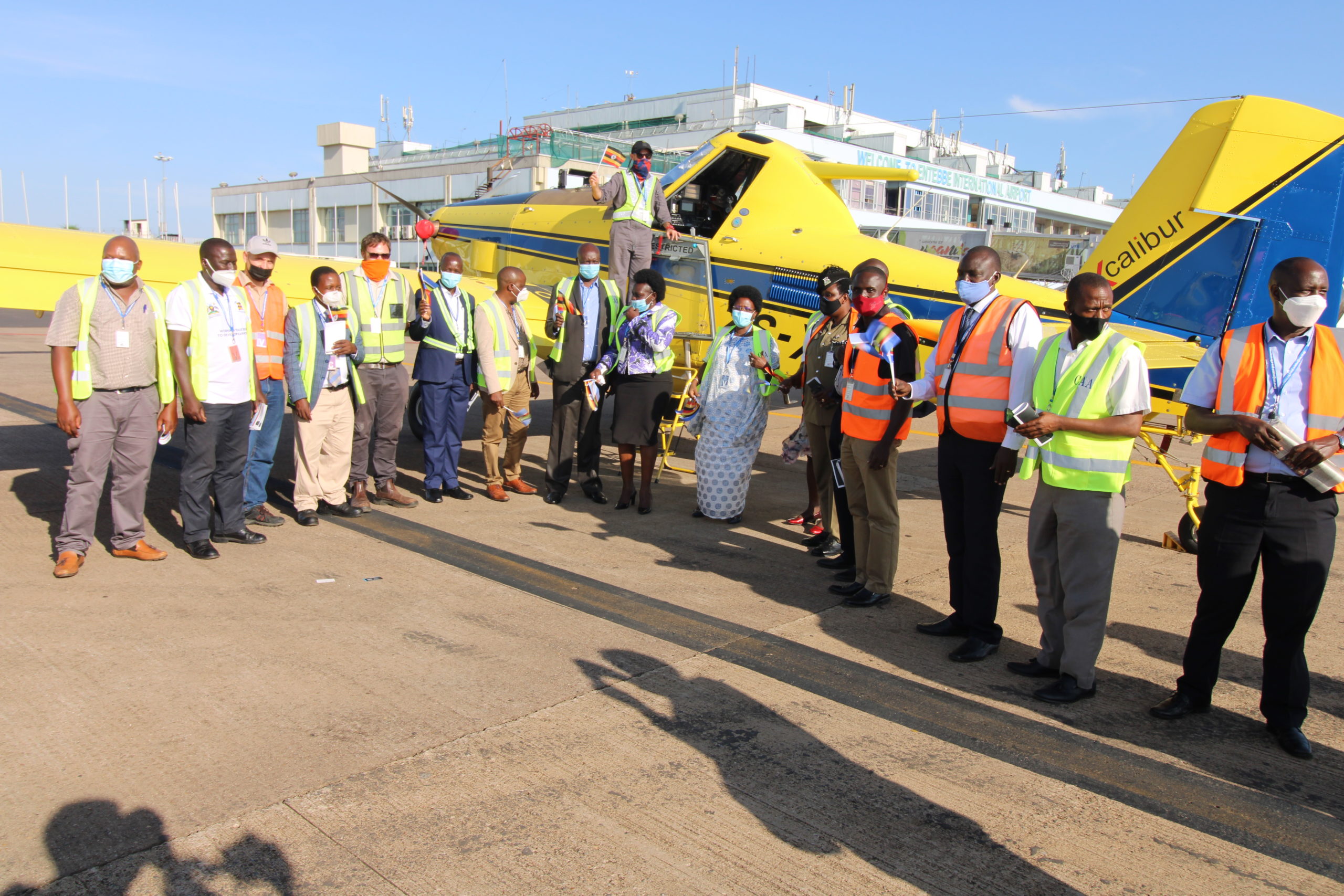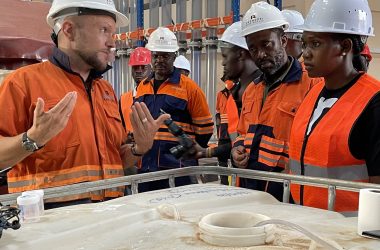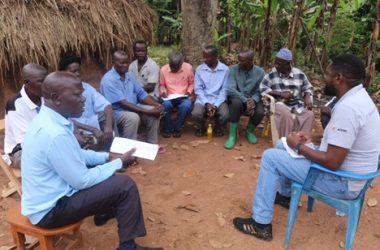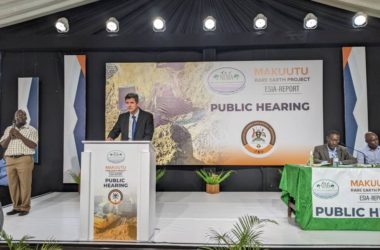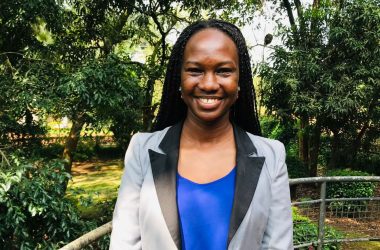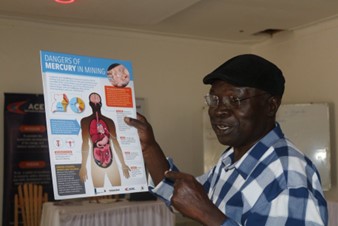Uganda’s Mining Sector has been identified as one of those with a high multiplier effect to reduce poverty and spur the country to socio-economic development. Alongside legal and regulatory reforms, several developments are ongoing to revamp it. Jennifer Hinton, the Uganda Country Head for Jervois Mining Ltd and Uganda Chamber of Mines and Petroleum (UCMP) Council member, talks to PLEXII’s ’s Robert Mwesigye on how to position Uganda as a mining destination.
As you definitely know a lot of things are going on in Uganda’s mining sector; the Karamoja airborne geophysical survey, the new Mining Bill that is pending (to be passed by the new Parliament), the ASM formalisation in progress, among others. As an investor, what are some of your expectations from the survey?
Having high-quality data sets is an important first step to attracting exploration companies. Without exploration, you will not make discoveries and without discoveries of economic deposits we won’t have mines.
Different geologic environments, different types and ages of rocks, different types of structures like faults or folds are suited to hosting different types of mineral deposits. The data from Karamoja’s airborne survey together with other essential geological data, such as geologic maps or reports, will give exploration companies insight into the geological setting in Karamoja and an idea of which areas in the region might host certain minerals.
As exploration is carried out, more and more data are collected and research is conducted over time. Companies will continue to use the airborne data with new data they generate to get a clearer picture of what might be going on below the surface.
Airborne geophysical data doesn’t immediately point you to a specific location of a mineral, not even close. But it is a very important step for the Karamoja Region because it provides critical information as a starting point. So, it definitely makes the area more attractive to prospective explorers who are considering Uganda as a place to invest.
Well, many stakeholders in the sector are anxious. In 2006 not many of us knew of this kind of exercise nor saw it. What, in your view, is a realistic timeline for the country to start seeing tangible benefits as a direct result of this geophysical survey?
To be clear, I am not briefed on the government timeframes. But I suspect the government will take a few years to collect the data and then process, interpret and package it.
But in terms of getting these tangible benefits like when the mining will start, for minerals such as gold, copper, nickel, platinum, for example, it takes about 6 to 10 years of investing in and carrying out exploration to make a discovery. It is a long process of mostly research and studies. And even after investing for two years, six years, ten years most exploration projects don’t succeed in making a discovery. Geology is very unpredictable. So, getting companies to take the risk to invest in Uganda or really any country is a challenge.
To reap the benefits, we need to attract as many exploration companies as possible – there are a few countries that have succeeded in attracting 20, 40 and even 60 or more exploration companies like mine (Jervois) that actually invest on the ground, employ a reasonable number of people, that spend money on local supplies and services, buying locally what they can.
But the most significant benefits really come when mines are constructed and operating, so the priority should be attracting lots of exploration companies to increase our chances of making discoveries in Uganda. However, for certain types of minerals, like limestone, marble and other ‘Development Minerals’, the time frame between exploration, discovery and mine development can be much shorter.
And what key areas should Uganda focus on to reap these tangible benefits from this geophysical survey?
There are Ugandan investors that want to or are already investing in mineral exploration or mining, I would encourage the DGSM – they have a phenomenal geoinformation center and extremely competent and highly trained geologists – to ensure that the airborne geodata is presented in a way that is usable and meaningful to Ugandans, especially in the case of smaller investors and miners. Exploration companies with more resources and expertise will have the means to interpret the data and make our own conclusions.
Whereas foreign investors are usually looking for the massive deposits that are turned into modern, industrial high-tech mines, often times you get a lot of smaller deposits which might be of interest in terms of benefitting smaller Ugandan investors.
How should Uganda as a potential mining investment destination prepare for the opportunities that will arise from this exercise? What should be our learning points?
I think this still depends on how many companies we succeed in attracting. A Ugandan enterprise for example wouldn’t make a whole business around supplying just my company with renting geophysical equipment that we use for 3 weeks in a year or by making the special soil sample bags that we need in exploration. It’s not a viable business unless there are a number of clients that they can sell goods or services to, especially for some of these specialized products.
The same goes for things like expertise needed. Right now, there is an overabundance of educated geologists eager to work and get experience but they don’t have enough job opportunities. In the mining sector we need to think about where the training and education gaps are and start focusing on building Ugandan capacity in these areas. But right now, with only a few companies active in the country, the real transformation can start when we succeed in attracting more investment to the sector. This would provide an important opportunity to employ especially these young people and build Ugandan expertise and hopefully create some new markets for local businesses as well.
Having interacted with several stakeholders in the mining sector, could you please paint a general picture of how this survey might act as a precursor for attracting investment in Uganda’s mining sector?
Of course, if we had a number of large, industrial, modern mines, this would be a big selling point to potential investors, but we aren’t there yet. Beyond this, exploration companies will look at different countries say, Malawi, Uganda, Peru, Mongolia, and one of the first things they look at is the law. Alongside this, they look at availability and quality of data and mineral information that they can build upon. Even before they decide to go to a country, this will give them a sense of what the potential might be for different types of mineral deposits. So, the data obtained from the survey is clearly important to attracting the type of investors Uganda wants and needs to transform the country into a mining destination.
You are an advisor to the Chamber of Mines; how would you advise for a more inclusive investment climate such that even the small companies you talked of can participate? What are those things that we should have in place to achieve a more inclusive mining environment?
As the Chamber of Mines, we noted a few aspects in the mining law that required small and medium size investors to meet the same compliance requirements as a larger company and that can be a barrier. For example, you would have high expectations of a larger company with respect to community development agreements but a smaller investor might not have the same resources and capacity.
Another issue is a lot of the local content provisions in the draft law seem to have come from oil and gas. What that means is if I have a camp and want to work with a local women’s association to build their capacity to supply things, if you impose the oil and gas provisions, they have to register with the Ministry of Energy and meet many other requirements and standards. The petroleum sector is very different so I would caution that there is a review done of all these potentially prohibitive measures in the mining law that just don’t make sense for the minerals sector.
The second thing is a lot of the packaging of the geodata is focused on the larger foreign companies. Can DGSM provide local investors with data in a way that’s useful to them and provide a mechanism for people to access some technical support?
The third thing is probably financing. Are small scale miners going to spend $2 million on a bankable feasibility study if they only have $50,000 to invest? Do we have financing mechanisms that are suited for different scales of mining? There are programmes in other countries for instance, in Nigeria, where the government puts up loan guarantees through local banks for licenced artisanal mining associations to access finance and then the government also provides them with geological information and supports studies needed so that financial institutions have some confidence in providing small loans.
There also seem to be opportunities in the mining law to better translate some commitments in the Minerals Policy into action. For example, where we’re required to do community consultation in the law, we should also be required to take steps to make the process inclusive for women, youth, disabled and those most vulnerable in communities.
Similarly, accountability is also needed to ensure actions taken by government are also inclusive. For example, for Mines Inspectors and others in DGSM, are their outreach programmes or trainings actually reaching the most affected people on the ground? Are they inclusive in terms of gender, socio-economic status, physical ability and other factors?
Collecting and disclosing data on performance is a good start so we can see if there is progress. It’s easy enough for companies to provide information like how many women or men we employ, if they are Ugandans or non-Ugandans, etc. Government should be required to disclose the same in terms of the composition of departments and their activities. The principle of “what gets measured gets done” is so important. If we have baseline data and regular reporting, it’s a starting point to seeing if we’re actually improving in terms of diversity and inclusivity in the sector over time.
From your time working in Uganda so far, what is your experience with the environment around the current legal framework governing the mining sector?
When the law came out around 2003/04, it was regarded as one of the best internationally but expectations have changed over time. For instance, with respect to community development obligations and local content, it’s very positive that requirements are quite clear in the new law before Parliament, but many of the gaps or concerns probably could have been addressed through an amendment to the current law and through better enforcement by DGSM, who quite often hasn’t had the resources they’ve needed. Of course, mechanisms to ensure the government is held accountable for the resources they receive are also key.
Our experience has been very positive in Uganda and we really want to see the sector thrive. But we and many others have serious concerns with the new law especially related to unpredictability and competitiveness with other countries. Some proposed provisions are unfortunately major deterrents. Yes, Uganda has mineral potential – which just means there is a possibility of discovering certain types of deposits. But so does Namibia, so does Canada, so does Chile. These countries also have mineral potential. If a new law increases the already high risks inherent in the sector, the likelihood that companies, especially credible companies – will go elsewhere is high.
We can learn a lot if we look globally at what is happening, where is the exploration investment going and where is it not going and why. Just because some legal provision is introduced in another country two or three years ago doesn’t mean it’s working; it doesn’t mean we should copy and paste it into our law. It seems sensible to benchmark against countries that have succeeded in attracting investment and who have had the growth trajectory and development outcomes that we want to see here. What might be the lessons learned for Uganda?
I think everyone who has been working in Uganda’s sector wants to see positive and significant contributions to development, but it’s a real concern that some aspects of the law before Parliament pose a real risk of deterring investment altogether.
Talking of DGSM, their latest 2019/2020 performance report cites an export ban on unprocessed minerals as a deterrent to attracting investment in the sector. They have noted a decline in mineral royalties’ revenue, production and export. What is your take?
Internationally, you do not have one mine and one refinery anymore. The size of smelters today is 10, 20 and even 30 times bigger than they used to be which means a smelter needs to source material from 5 or 10 mines or more to operate. The bigger it is, usually the lower your production costs. So, if the metal is 10 times more expensive to produce from a really small smelter than a large one, who will buy your product at 10 times the going rate? We want value addition but any project must be financially and technically sound.
Currently, we have very few mines in Uganda and these are small scale so the total production volumes of different minerals is pretty low. The ban is basically the same as requiring these small mines to build a smelter or refinery that will also be small which doesn’t make them competitive. Because of the ban, many of these small mines have closed, many have lost jobs and local economies and families are suffering a lot. We are seeing this in Ntungamo and Kabale and other places now.
Discovering just one large and economically viable deposit that can effectively be developed into a mine takes years of research and investment and you would be very, very lucky.
The ban is a major deterrent to attracting exploration companies. The main goal of exploration is to make a discovery of a mineral deposit that can successfully be developed into a profitable mine. Let’s say a company succeeds having invested millions of dollars. Would someone invest $300 million to build the mine, then produce and stockpile mineral concentrates and then sit and wait in the hope that 5 other companies might do the same as needed to justify a smelter? Probably not. So, unfortunately, the ban means you probably won’t even start exploration in that country to begin with. Exploration companies will go elsewhere.
In simplest terms, no exploration means no discoveries. No discoveries means no mines. No mines means no minerals to add value to.
To take steps towards in-country value addition, it’s important to benchmark with other countries. In terms of essential requirements, Uganda is phenomenally well-positioned with respect to energy. Coordination between sectors, for instance on roads and other infrastructure, seems to be improving rapidly. Moving towards regional integration is important too. Can we source certain types of mineral concentrates from neighbouring countries to justify the volumes we need for a large smelter or refinery? How about transportation costs and other inputs? And the expertise needed – smelters and refineries need very specialized skills and these skills are often very specific to different types of metals and minerals. Are we building Ugandan capacity in processing, refining and smelting and, if so, for what minerals and metals? These are just a few key factors that we need to consider.
Having said that, there seems to be a misconception that mine developers and operators don’t even consider downstream processing, refining and smelting. We want minerals value addition to become a reality but it seems we need a more holistic strategy and concrete roadmap to create the conditions needed to make it possible.
Having talked about several issues and what government is trying to put in place to move the sector forward – we are perhaps biting off too much than we can chew – what do you see as those realistic obtainable goals for us as a country in the sector?
My experience is that companies looking to Uganda first ask questions about the mining law and the export ban which are pretty fundamental and will actually determine the trajectory of the sector for the next ten or twenty years. If we succeed in attracting serious companies while supporting local investors in the sector, then we can start looking at linkages between mining and other aspects of the economy like infrastructure, tourism, agriculture and other sectors, to have a high multiplier effect and really contribute to creating wealth, quality jobs and all the other development benefits we want to see.
As a simple example, in the old days, mines used to have camps, a hospital, housing and everything was controlled by the mining company but that has changed completely. Now you would support independent small or medium enterprises to meet the needs of the mine. For example, like working with a local workshop to meet the standards needed to maintain a fleet of vehicles.
In Kasese, think of all those tourism companies with their safari vehicles, if a vehicle has a problem, they often send it back to Kampala or send their own mechanic. If the capacity to meet the standards were already there, then local businesses would thrive through not just the mine but through these other opportunities.
As another example, mining companies are not in the business of running hospitals but they need to meet international standards for their workforces. So, working with government to bring Kilembe hospital up to this standard would of course have a bigger development impact far beyond the mine. So, the question becomes, what can be possible for agriculture, for example through a rail line, or conservation, or clean energy or any number of things. There are a lot of spin-off benefits that responsible companies would consider in 2021 that they weren’t really expected to think about in 1970.
So as a realistic goal, let’s do our best to create the conditions needed to attract credible exploration and mining companies. While we do that, let’s ensure that Ugandan investors are not excluded through legal barriers; and artisanal mining is formalized in a way that does not leave those most vulnerable behind. If we can do that, then things could change quite quickly in a positive direction.

